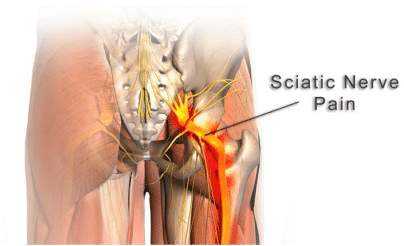In our clinic, one of the most common issues I get asked about is sciatica. So what actually is sciatica anyways? Sciatica is a term used to refer to pain which radiates along the sciatic nerve. Sciatic nerve pain is a symptom of an underlying musculoskeletal problem.
The sciatic nerve is the largest single nerve in our body. It begins from your lower lumbar region (L3), and travels through the buttock region, down the back of your thigh before it branches below the knee. When it becomes irritated, you may experience leg pain/tingling/numbness, lower limb weakness, burning or ‘electrical’ sensations down the back of your leg from the buttock to the ankle.
The length of the sciatic nerve, and the fact that it originates from the low back, makes it susceptible to irritation from a number of different sources. Most commonly, sciatic nerve issues result from lumbar disc injury or herniation, degenerative disc disease, spinal stenosis, and low back muscle strains. Additionally, it can arise from piriformis syndrome, as the nerve passes through the muscles in the buttock region. Pregnancy and sacroiliac joint issues can also lead to sciatic nerve pain. Some may find the pain is made worse with sitting, and sometimes the pain may not travel beyond the buttock.
Treatment for sciatic nerve pain is individualized for each patient, due to the fact that the pain may come from one of many sources. If you encounter sciatic nerve pain, you should work with your chiropractor to determine the cause of your pain, and the best course of treatment. Exercise and activity are important steps you can take towards improving your symptoms. Staying active will keep your muscles conditioned, and will encourage movement in the spine resulting in an improved flow of nutrients to your ligaments and joints. You should avoid high impact activities, and continue with your regular tasks and light exercise. Contrary to common belief, bed rest is not appropriate and may lead to your symptoms being prolonged or worsened. Bed rest is only appropriate in rare cases -if your pain is so severe you cannot move- and should be limited to only a day or two.
Some of the common recommendations I make to patients include walking, gentle strengthening of core muscles, stretching of target muscles, low impact aerobics, and nerve flossing. It is important to seek out advice on which activities would help your specific cause of sciatic nerve pain, as the wrong exercises may in fact worsen your symptoms. Chiropractic care helps to decrease your symptoms, and your chiropractor can provide advice on how to prevent future sciatic nerve pain from reoccurring. For most, symptoms of sciatica should resolve with appropriate conservative treatment.
Feeling some Sciatic nerve symptoms? Book your assessment with Dr Hamilton >>>>

